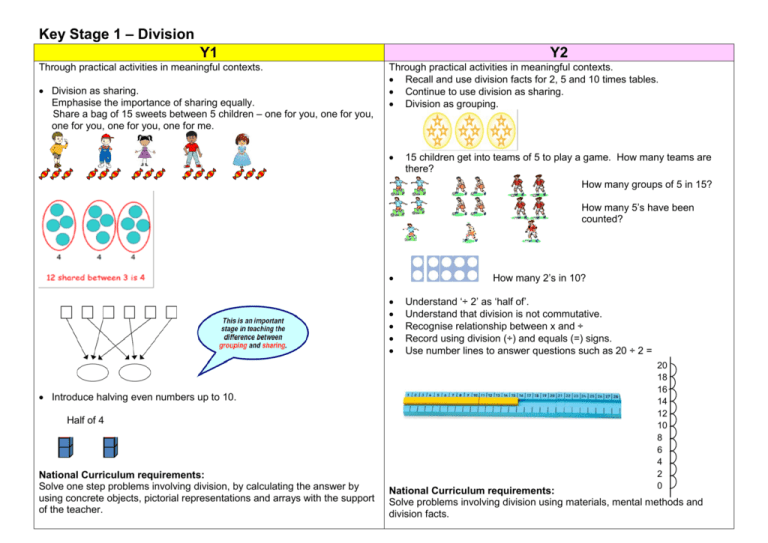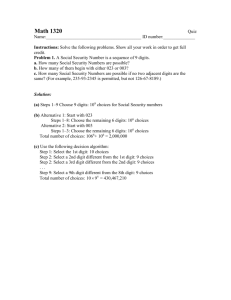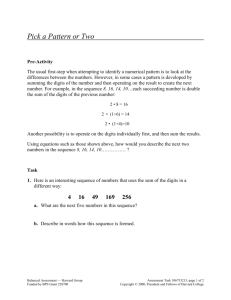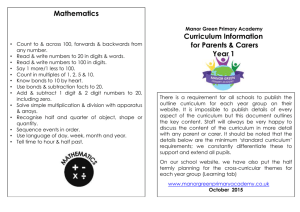Division - Hazelwood Schools
advertisement

Key Stage 1 – Division Y1 Through practical activities in meaningful contexts. Division as sharing. Emphasise the importance of sharing equally. Share a bag of 15 sweets between 5 children – one for you, one for you, one for you, one for you, one for me. Y2 Through practical activities in meaningful contexts. Recall and use division facts for 2, 5 and 10 times tables. Continue to use division as sharing. Division as grouping. 15 children get into teams of 5 to play a game. How many teams are there? How many groups of 5 in 15? How many 5’s have been counted? Introduce halving even numbers up to 10. Half of 4 National Curriculum requirements: Solve one step problems involving division, by calculating the answer by using concrete objects, pictorial representations and arrays with the support of the teacher. How many 2’s in 10? Understand ‘÷ 2’ as ‘half of’. Understand that division is not commutative. Recognise relationship between x and ÷ Record using division (÷) and equals (=) signs. Use number lines to answer questions such as 20 ÷ 2 = 20 18 16 14 12 10 8 6 4 2 0 National Curriculum requirements: Solve problems involving division using materials, mental methods and division facts. Key Stage 2 – Division Y3 Recall and use division facts for 3, 4, and 8 times tables. Continue with repeated subtraction on a vertical number line. Write and calculate mathematical statements for division using the tables they know. Y4 Recall and use all division facts for all tables up to 12 (Including dividing by 1). Continue with short division method. Introduce grouping method before short division, encourage children to estimate answers before attempting calculation. Create fact box to encourage efficient grouping e.g. not always groups of 10 - 1x, 2x, 5x, 10x, 20x, 50x, 100x. 13 5) 65 - 50 (5 x 10) 15 - 15 (5 x 3) 0 Introduce short division, with exact answers. Progressing to short division with remainders. 2 0 4 4) 8 1 16 1 4 1 r1 3) 4 12 4 Progressing to short division involving carrying, with exact answers. Divide 2 digits by 1 digit, progressing to formal written methods. National Curriculum requirements: Divide 2 digits by 1 digit and 3 digits by 1 digit becoming fluent with formal written method of short division with exact answers and progressing to remainders. The National Curriculum statutory requirements for Year 3 and the use of written methods are not clear therefore our guidance for Year 3 has been based on the skills required to access Year 4 statutory requirements. The National Curriculum statutory requirements for Year 4 and the use of written methods are not clear therefore our guidance for Year 4 has been based on the skills required to access Year 5 statutory requirements. National Curriculum requirements: Division questions based on multiplication tables they know. Key Stage 2 – Division Y5 Consolidate the use of the formal written method of short division. Y6 Consolidate short division. Children should be able to interpret remainders as whole number remainders, fractions or by rounding, as appropriate for the context. National Curriculum requirements: Divide 2 digits by 1 digit. Divide 3 digits by 1 digit. Divide 4 digits by 1 digit. Children interpret the remainders appropriately for the context. e.g. as fractions, decimals or by rounding 98÷4 = 98/4 = 24r2 = 24 ½ = 24.5 rounded to 25 Divide whole numbers and those involving decimals by 10, 100, 1000. Introduce long division. N.B: The above examples are taken from the National Curriculum for Mathematics appendix. National Curriculum requirements: Divide numbers up to 4 digits by a 2 digit number using the formal written method of short division where appropriate. Divide up to 4 digits by a 2 digits whole number using the formal written method of long division.









